University Electrical Engineering: Power Systems and Circuit Analysis
VerifiedAdded on 2022/10/07
|10
|1877
|16
Homework Assignment
AI Summary
This electrical engineering assignment solution covers a range of topics, including multiple-choice questions and calculation problems. The assignment delves into fundamental concepts such as impedance, phasors, per-unit calculations, and three-phase circuits. Specific topics include analysis of series circuits, calculations of XL, Xc, total impedance, and current. Furthermore, the assignment explores power calculations, including apparent power, true power, reactive power, and power factor determination. It also involves the analysis of unbalanced delta and star-connected loads, requiring the application of Kirchhoff's laws and Thevenin equivalent circuits. The solution provides detailed steps and answers for each question, offering a comprehensive guide for students studying electrical engineering.
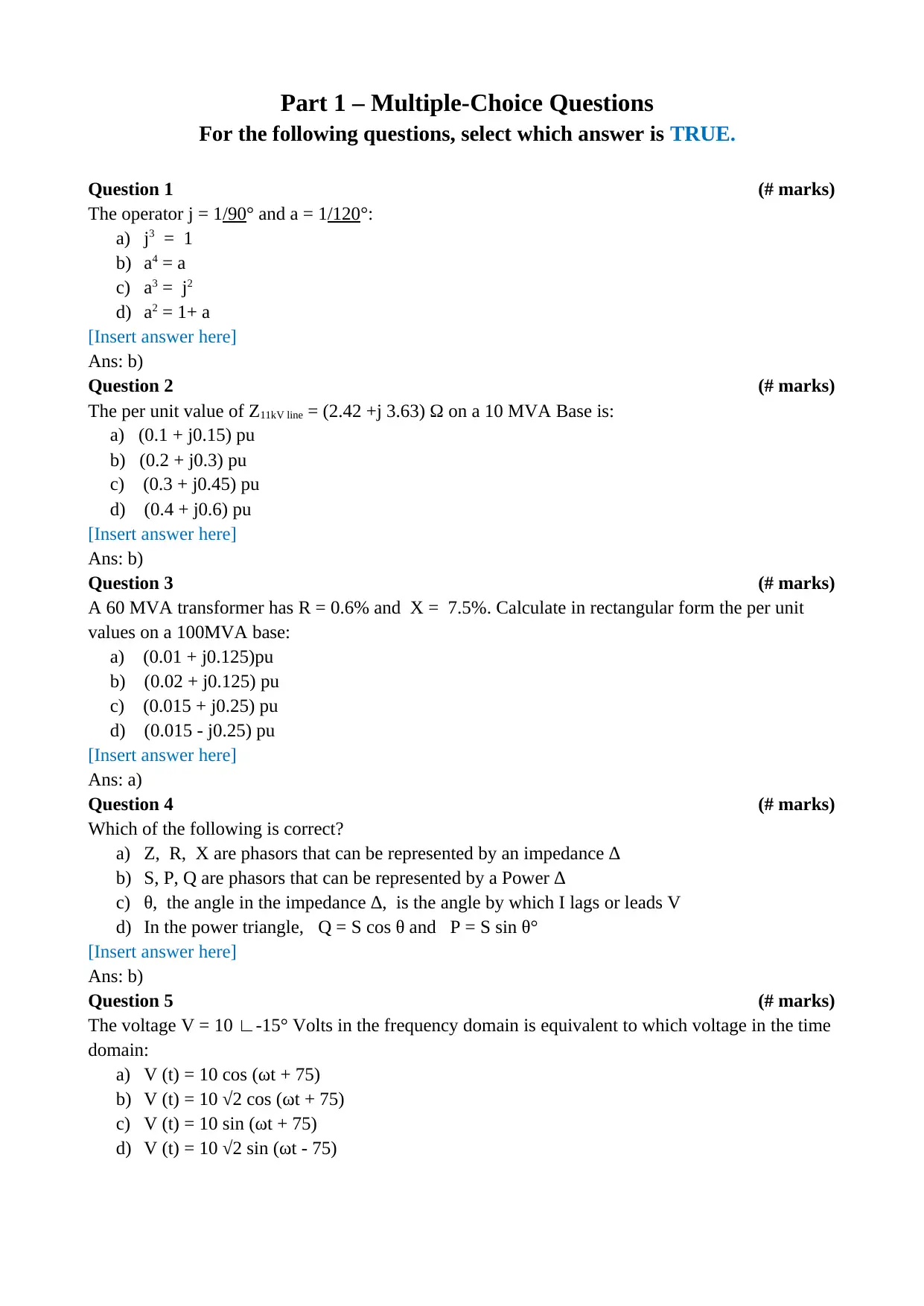
Part 1 – Multiple-Choice Questions
For the following questions, select which answer is TRUE.
Question 1 (# marks)
The operator j = 1/90° and a = 1/120°:
a) j3 = 1
b) a4 = a
c) a3 = j2
d) a2 = 1+ a
[Insert answer here]
Ans: b)
Question 2 (# marks)
The per unit value of Z11kV line = (2.42 +j 3.63) Ω on a 10 MVA Base is:
a) (0.1 + j0.15) pu
b) (0.2 + j0.3) pu
c) (0.3 + j0.45) pu
d) (0.4 + j0.6) pu
[Insert answer here]
Ans: b)
Question 3 (# marks)
A 60 MVA transformer has R = 0.6% and X = 7.5%. Calculate in rectangular form the per unit
values on a 100MVA base:
a) (0.01 + j0.125)pu
b) (0.02 + j0.125) pu
c) (0.015 + j0.25) pu
d) (0.015 - j0.25) pu
[Insert answer here]
Ans: a)
Question 4 (# marks)
Which of the following is correct?
a) Z, R, X are phasors that can be represented by an impedance ∆
b) S, P, Q are phasors that can be represented by a Power ∆
c) θ, the angle in the impedance ∆, is the angle by which I lags or leads V
d) In the power triangle, Q = S cos θ and P = S sin θ°
[Insert answer here]
Ans: b)
Question 5 (# marks)
The voltage V = 10 ∟-15° Volts in the frequency domain is equivalent to which voltage in the time
domain:
a) V (t) = 10 cos (ωt + 75)
b) V (t) = 10 √2 cos (ωt + 75)
c) V (t) = 10 sin (ωt + 75)
d) V (t) = 10 √2 sin (ωt - 75)
For the following questions, select which answer is TRUE.
Question 1 (# marks)
The operator j = 1/90° and a = 1/120°:
a) j3 = 1
b) a4 = a
c) a3 = j2
d) a2 = 1+ a
[Insert answer here]
Ans: b)
Question 2 (# marks)
The per unit value of Z11kV line = (2.42 +j 3.63) Ω on a 10 MVA Base is:
a) (0.1 + j0.15) pu
b) (0.2 + j0.3) pu
c) (0.3 + j0.45) pu
d) (0.4 + j0.6) pu
[Insert answer here]
Ans: b)
Question 3 (# marks)
A 60 MVA transformer has R = 0.6% and X = 7.5%. Calculate in rectangular form the per unit
values on a 100MVA base:
a) (0.01 + j0.125)pu
b) (0.02 + j0.125) pu
c) (0.015 + j0.25) pu
d) (0.015 - j0.25) pu
[Insert answer here]
Ans: a)
Question 4 (# marks)
Which of the following is correct?
a) Z, R, X are phasors that can be represented by an impedance ∆
b) S, P, Q are phasors that can be represented by a Power ∆
c) θ, the angle in the impedance ∆, is the angle by which I lags or leads V
d) In the power triangle, Q = S cos θ and P = S sin θ°
[Insert answer here]
Ans: b)
Question 5 (# marks)
The voltage V = 10 ∟-15° Volts in the frequency domain is equivalent to which voltage in the time
domain:
a) V (t) = 10 cos (ωt + 75)
b) V (t) = 10 √2 cos (ωt + 75)
c) V (t) = 10 sin (ωt + 75)
d) V (t) = 10 √2 sin (ωt - 75)
Paraphrase This Document
Need a fresh take? Get an instant paraphrase of this document with our AI Paraphraser
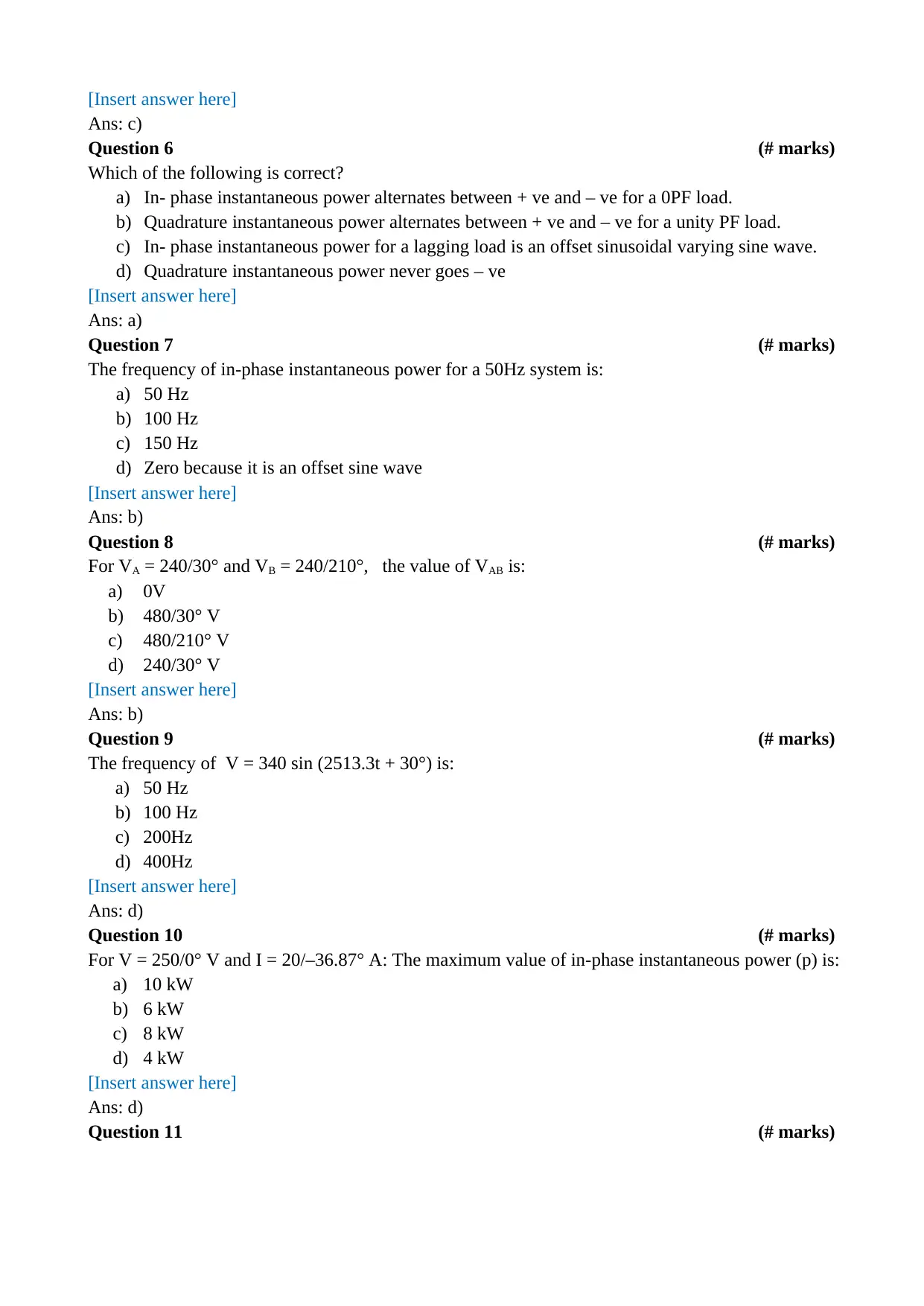
[Insert answer here]
Ans: c)
Question 6 (# marks)
Which of the following is correct?
a) In- phase instantaneous power alternates between + ve and – ve for a 0PF load.
b) Quadrature instantaneous power alternates between + ve and – ve for a unity PF load.
c) In- phase instantaneous power for a lagging load is an offset sinusoidal varying sine wave.
d) Quadrature instantaneous power never goes – ve
[Insert answer here]
Ans: a)
Question 7 (# marks)
The frequency of in-phase instantaneous power for a 50Hz system is:
a) 50 Hz
b) 100 Hz
c) 150 Hz
d) Zero because it is an offset sine wave
[Insert answer here]
Ans: b)
Question 8 (# marks)
For VA = 240/30° and VB = 240/210°, the value of VAB is:
a) 0V
b) 480/30° V
c) 480/210° V
d) 240/30° V
[Insert answer here]
Ans: b)
Question 9 (# marks)
The frequency of V = 340 sin (2513.3t + 30°) is:
a) 50 Hz
b) 100 Hz
c) 200Hz
d) 400Hz
[Insert answer here]
Ans: d)
Question 10 (# marks)
For V = 250/0° V and I = 20/–36.87° A: The maximum value of in-phase instantaneous power (p) is:
a) 10 kW
b) 6 kW
c) 8 kW
d) 4 kW
[Insert answer here]
Ans: d)
Question 11 (# marks)
Ans: c)
Question 6 (# marks)
Which of the following is correct?
a) In- phase instantaneous power alternates between + ve and – ve for a 0PF load.
b) Quadrature instantaneous power alternates between + ve and – ve for a unity PF load.
c) In- phase instantaneous power for a lagging load is an offset sinusoidal varying sine wave.
d) Quadrature instantaneous power never goes – ve
[Insert answer here]
Ans: a)
Question 7 (# marks)
The frequency of in-phase instantaneous power for a 50Hz system is:
a) 50 Hz
b) 100 Hz
c) 150 Hz
d) Zero because it is an offset sine wave
[Insert answer here]
Ans: b)
Question 8 (# marks)
For VA = 240/30° and VB = 240/210°, the value of VAB is:
a) 0V
b) 480/30° V
c) 480/210° V
d) 240/30° V
[Insert answer here]
Ans: b)
Question 9 (# marks)
The frequency of V = 340 sin (2513.3t + 30°) is:
a) 50 Hz
b) 100 Hz
c) 200Hz
d) 400Hz
[Insert answer here]
Ans: d)
Question 10 (# marks)
For V = 250/0° V and I = 20/–36.87° A: The maximum value of in-phase instantaneous power (p) is:
a) 10 kW
b) 6 kW
c) 8 kW
d) 4 kW
[Insert answer here]
Ans: d)
Question 11 (# marks)
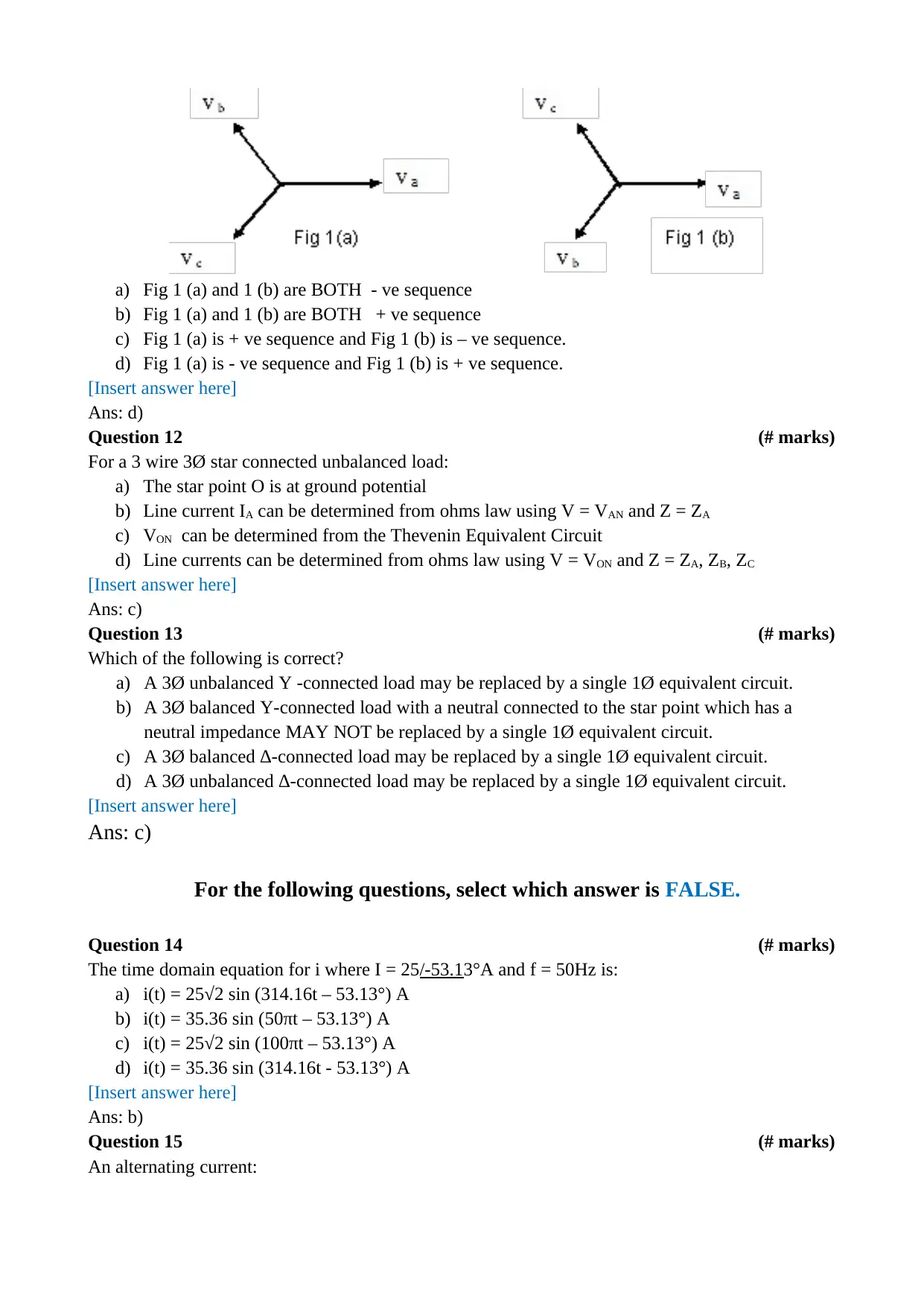
a) Fig 1 (a) and 1 (b) are BOTH - ve sequence
b) Fig 1 (a) and 1 (b) are BOTH + ve sequence
c) Fig 1 (a) is + ve sequence and Fig 1 (b) is – ve sequence.
d) Fig 1 (a) is - ve sequence and Fig 1 (b) is + ve sequence.
[Insert answer here]
Ans: d)
Question 12 (# marks)
For a 3 wire 3Ø star connected unbalanced load:
a) The star point O is at ground potential
b) Line current IA can be determined from ohms law using V = VAN and Z = ZA
c) VON can be determined from the Thevenin Equivalent Circuit
d) Line currents can be determined from ohms law using V = VON and Z = ZA, ZB, ZC
[Insert answer here]
Ans: c)
Question 13 (# marks)
Which of the following is correct?
a) A 3Ø unbalanced Y -connected load may be replaced by a single 1Ø equivalent circuit.
b) A 3Ø balanced Y-connected load with a neutral connected to the star point which has a
neutral impedance MAY NOT be replaced by a single 1Ø equivalent circuit.
c) A 3Ø balanced ∆-connected load may be replaced by a single 1Ø equivalent circuit.
d) A 3Ø unbalanced ∆-connected load may be replaced by a single 1Ø equivalent circuit.
[Insert answer here]
Ans: c)
For the following questions, select which answer is FALSE.
Question 14 (# marks)
The time domain equation for i where I = 25/-53.13°A and f = 50Hz is:
a) i(t) = 25√2 sin (314.16t – 53.13°) A
b) i(t) = 35.36 sin (50πt – 53.13°) A
c) i(t) = 25√2 sin (100πt – 53.13°) A
d) i(t) = 35.36 sin (314.16t - 53.13°) A
[Insert answer here]
Ans: b)
Question 15 (# marks)
An alternating current:
b) Fig 1 (a) and 1 (b) are BOTH + ve sequence
c) Fig 1 (a) is + ve sequence and Fig 1 (b) is – ve sequence.
d) Fig 1 (a) is - ve sequence and Fig 1 (b) is + ve sequence.
[Insert answer here]
Ans: d)
Question 12 (# marks)
For a 3 wire 3Ø star connected unbalanced load:
a) The star point O is at ground potential
b) Line current IA can be determined from ohms law using V = VAN and Z = ZA
c) VON can be determined from the Thevenin Equivalent Circuit
d) Line currents can be determined from ohms law using V = VON and Z = ZA, ZB, ZC
[Insert answer here]
Ans: c)
Question 13 (# marks)
Which of the following is correct?
a) A 3Ø unbalanced Y -connected load may be replaced by a single 1Ø equivalent circuit.
b) A 3Ø balanced Y-connected load with a neutral connected to the star point which has a
neutral impedance MAY NOT be replaced by a single 1Ø equivalent circuit.
c) A 3Ø balanced ∆-connected load may be replaced by a single 1Ø equivalent circuit.
d) A 3Ø unbalanced ∆-connected load may be replaced by a single 1Ø equivalent circuit.
[Insert answer here]
Ans: c)
For the following questions, select which answer is FALSE.
Question 14 (# marks)
The time domain equation for i where I = 25/-53.13°A and f = 50Hz is:
a) i(t) = 25√2 sin (314.16t – 53.13°) A
b) i(t) = 35.36 sin (50πt – 53.13°) A
c) i(t) = 25√2 sin (100πt – 53.13°) A
d) i(t) = 35.36 sin (314.16t - 53.13°) A
[Insert answer here]
Ans: b)
Question 15 (# marks)
An alternating current:
⊘ This is a preview!⊘
Do you want full access?
Subscribe today to unlock all pages.

Trusted by 1+ million students worldwide
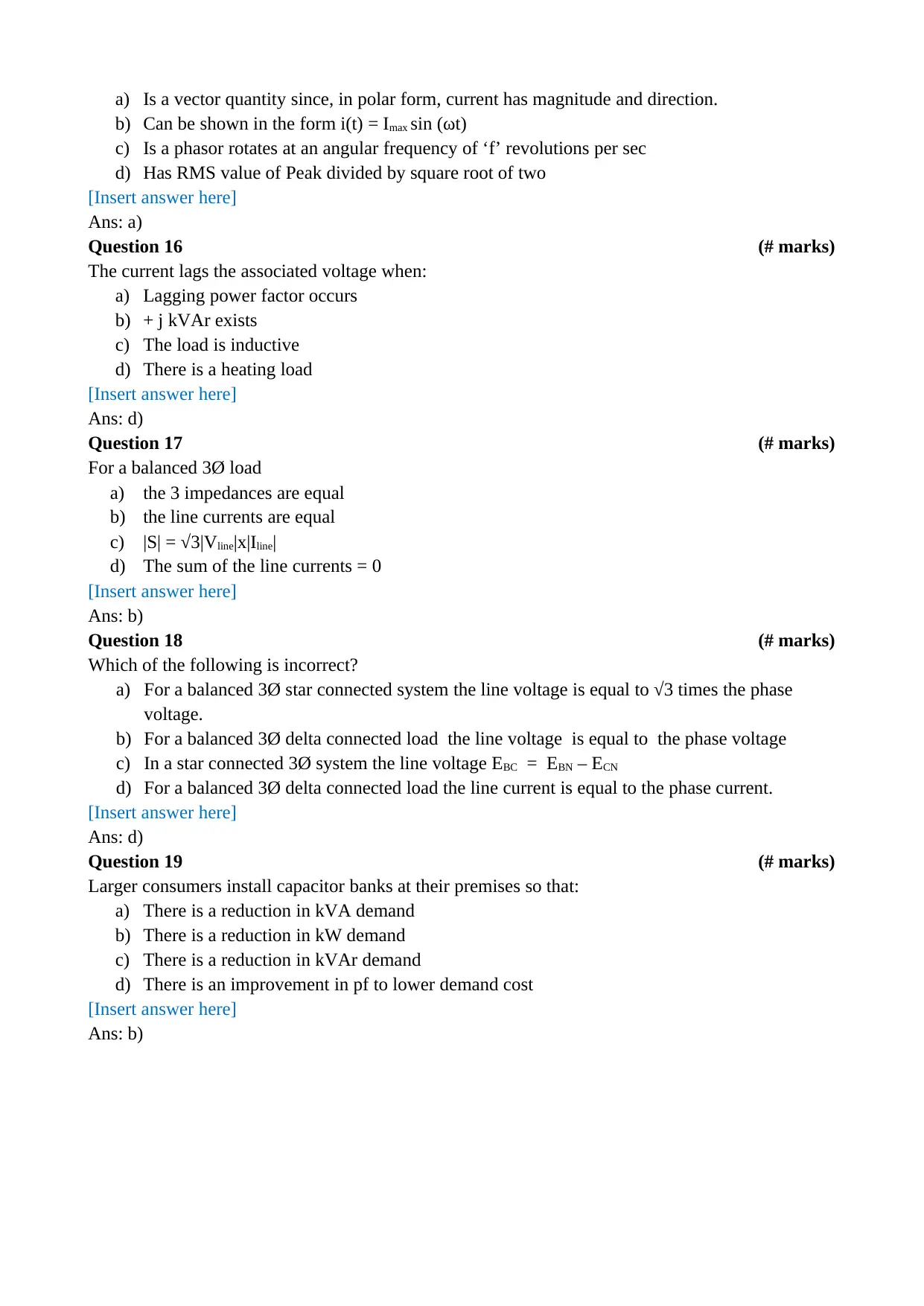
a) Is a vector quantity since, in polar form, current has magnitude and direction.
b) Can be shown in the form i(t) = Imax sin (ωt)
c) Is a phasor rotates at an angular frequency of ‘f’ revolutions per sec
d) Has RMS value of Peak divided by square root of two
[Insert answer here]
Ans: a)
Question 16 (# marks)
The current lags the associated voltage when:
a) Lagging power factor occurs
b) + j kVAr exists
c) The load is inductive
d) There is a heating load
[Insert answer here]
Ans: d)
Question 17 (# marks)
For a balanced 3Ø load
a) the 3 impedances are equal
b) the line currents are equal
c) |S| = √3|Vline|x|Iline|
d) The sum of the line currents = 0
[Insert answer here]
Ans: b)
Question 18 (# marks)
Which of the following is incorrect?
a) For a balanced 3Ø star connected system the line voltage is equal to √3 times the phase
voltage.
b) For a balanced 3Ø delta connected load the line voltage is equal to the phase voltage
c) In a star connected 3Ø system the line voltage EBC = EBN – ECN
d) For a balanced 3Ø delta connected load the line current is equal to the phase current.
[Insert answer here]
Ans: d)
Question 19 (# marks)
Larger consumers install capacitor banks at their premises so that:
a) There is a reduction in kVA demand
b) There is a reduction in kW demand
c) There is a reduction in kVAr demand
d) There is an improvement in pf to lower demand cost
[Insert answer here]
Ans: b)
b) Can be shown in the form i(t) = Imax sin (ωt)
c) Is a phasor rotates at an angular frequency of ‘f’ revolutions per sec
d) Has RMS value of Peak divided by square root of two
[Insert answer here]
Ans: a)
Question 16 (# marks)
The current lags the associated voltage when:
a) Lagging power factor occurs
b) + j kVAr exists
c) The load is inductive
d) There is a heating load
[Insert answer here]
Ans: d)
Question 17 (# marks)
For a balanced 3Ø load
a) the 3 impedances are equal
b) the line currents are equal
c) |S| = √3|Vline|x|Iline|
d) The sum of the line currents = 0
[Insert answer here]
Ans: b)
Question 18 (# marks)
Which of the following is incorrect?
a) For a balanced 3Ø star connected system the line voltage is equal to √3 times the phase
voltage.
b) For a balanced 3Ø delta connected load the line voltage is equal to the phase voltage
c) In a star connected 3Ø system the line voltage EBC = EBN – ECN
d) For a balanced 3Ø delta connected load the line current is equal to the phase current.
[Insert answer here]
Ans: d)
Question 19 (# marks)
Larger consumers install capacitor banks at their premises so that:
a) There is a reduction in kVA demand
b) There is a reduction in kW demand
c) There is a reduction in kVAr demand
d) There is an improvement in pf to lower demand cost
[Insert answer here]
Ans: b)
Paraphrase This Document
Need a fresh take? Get an instant paraphrase of this document with our AI Paraphraser
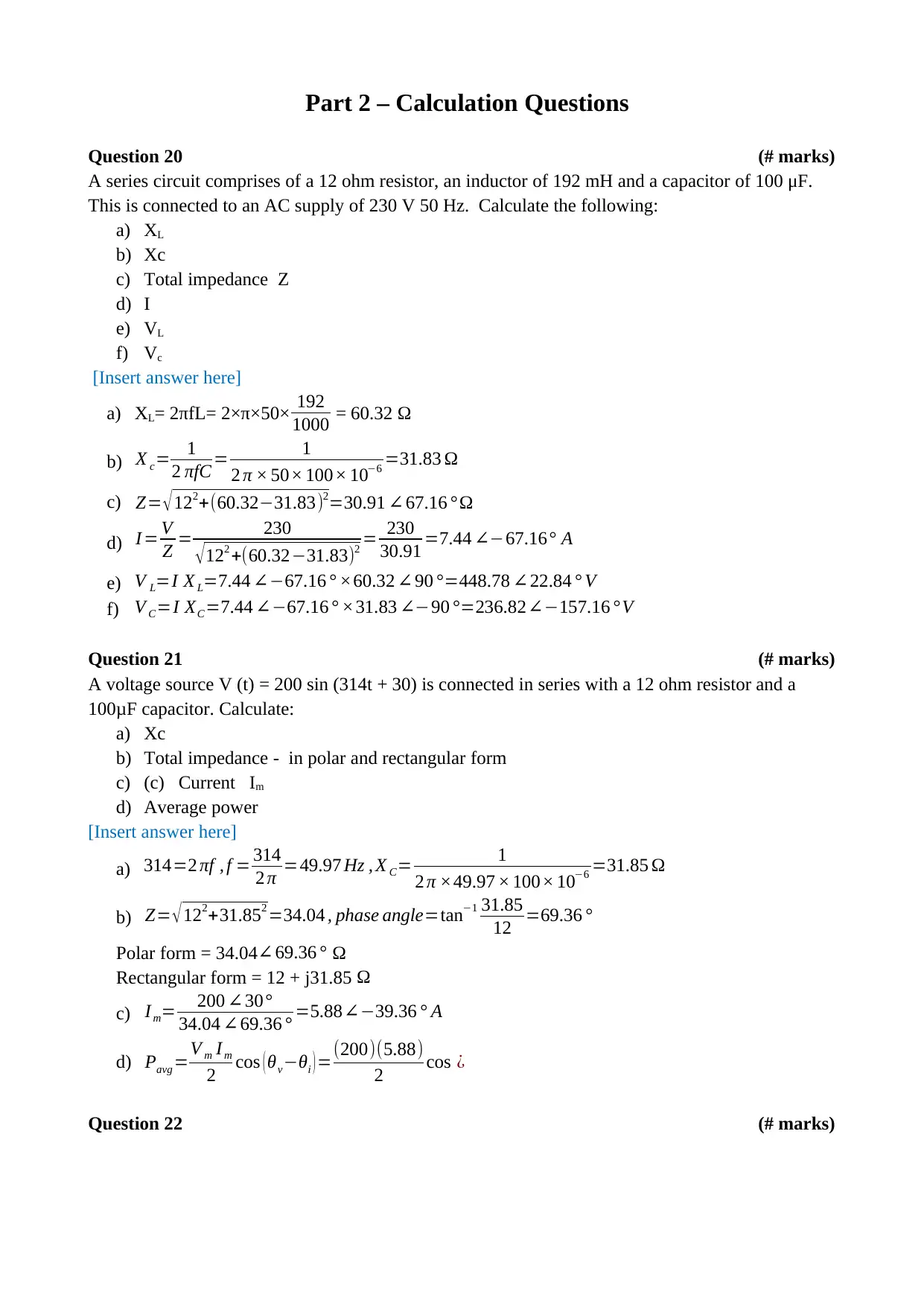
Part 2 – Calculation Questions
Question 20 (# marks)
A series circuit comprises of a 12 ohm resistor, an inductor of 192 mH and a capacitor of 100 μF.
This is connected to an AC supply of 230 V 50 Hz. Calculate the following:
a) XL
b) Xc
c) Total impedance Z
d) I
e) VL
f) Vc
[Insert answer here]
a) XL= 2πfL= 2×π×50× 192
1000 = 60.32 Ω
b) X c= 1
2 πfC = 1
2 π × 50× 100× 10−6 =31.83 Ω
c) Z= √122+(60.32−31.83)2=30.91 ∠ 67.16 °Ω
d) I = V
Z = 230
√ 122 +(60.32−31.83)2 = 230
30.91 =7.44 ∠−67.16° A
e) V L=I X L=7.44 ∠−67.16 ° ×60.32 ∠90 °=448.78 ∠22.84 ° V
f) V C=I XC=7.44 ∠−67.16 ° ×31.83 ∠−90 °=236.82∠−157.16 °V
Question 21 (# marks)
A voltage source V (t) = 200 sin (314t + 30) is connected in series with a 12 ohm resistor and a
100μF capacitor. Calculate:
a) Xc
b) Total impedance - in polar and rectangular form
c) (c) Current Im
d) Average power
[Insert answer here]
a) 314=2 πf , f = 314
2 π =49.97 Hz , X C= 1
2 π ×49.97 × 100× 10−6 =31.85 Ω
b) Z= √ 122+31.852 =34.04 , phase angle=tan−1 31.85
12 =69.36 °
Polar form = 34.04 ∠69.36 ° Ω
Rectangular form = 12 + j31.85 Ω
c) I m= 200 ∠30°
34.04 ∠69.36 ° =5.88∠−39.36 ° A
d) Pavg =V m I m
2 cos ( θv−θi ) =(200)(5.88)
2 cos ¿
Question 22 (# marks)
Question 20 (# marks)
A series circuit comprises of a 12 ohm resistor, an inductor of 192 mH and a capacitor of 100 μF.
This is connected to an AC supply of 230 V 50 Hz. Calculate the following:
a) XL
b) Xc
c) Total impedance Z
d) I
e) VL
f) Vc
[Insert answer here]
a) XL= 2πfL= 2×π×50× 192
1000 = 60.32 Ω
b) X c= 1
2 πfC = 1
2 π × 50× 100× 10−6 =31.83 Ω
c) Z= √122+(60.32−31.83)2=30.91 ∠ 67.16 °Ω
d) I = V
Z = 230
√ 122 +(60.32−31.83)2 = 230
30.91 =7.44 ∠−67.16° A
e) V L=I X L=7.44 ∠−67.16 ° ×60.32 ∠90 °=448.78 ∠22.84 ° V
f) V C=I XC=7.44 ∠−67.16 ° ×31.83 ∠−90 °=236.82∠−157.16 °V
Question 21 (# marks)
A voltage source V (t) = 200 sin (314t + 30) is connected in series with a 12 ohm resistor and a
100μF capacitor. Calculate:
a) Xc
b) Total impedance - in polar and rectangular form
c) (c) Current Im
d) Average power
[Insert answer here]
a) 314=2 πf , f = 314
2 π =49.97 Hz , X C= 1
2 π ×49.97 × 100× 10−6 =31.85 Ω
b) Z= √ 122+31.852 =34.04 , phase angle=tan−1 31.85
12 =69.36 °
Polar form = 34.04 ∠69.36 ° Ω
Rectangular form = 12 + j31.85 Ω
c) I m= 200 ∠30°
34.04 ∠69.36 ° =5.88∠−39.36 ° A
d) Pavg =V m I m
2 cos ( θv−θi ) =(200)(5.88)
2 cos ¿
Question 22 (# marks)
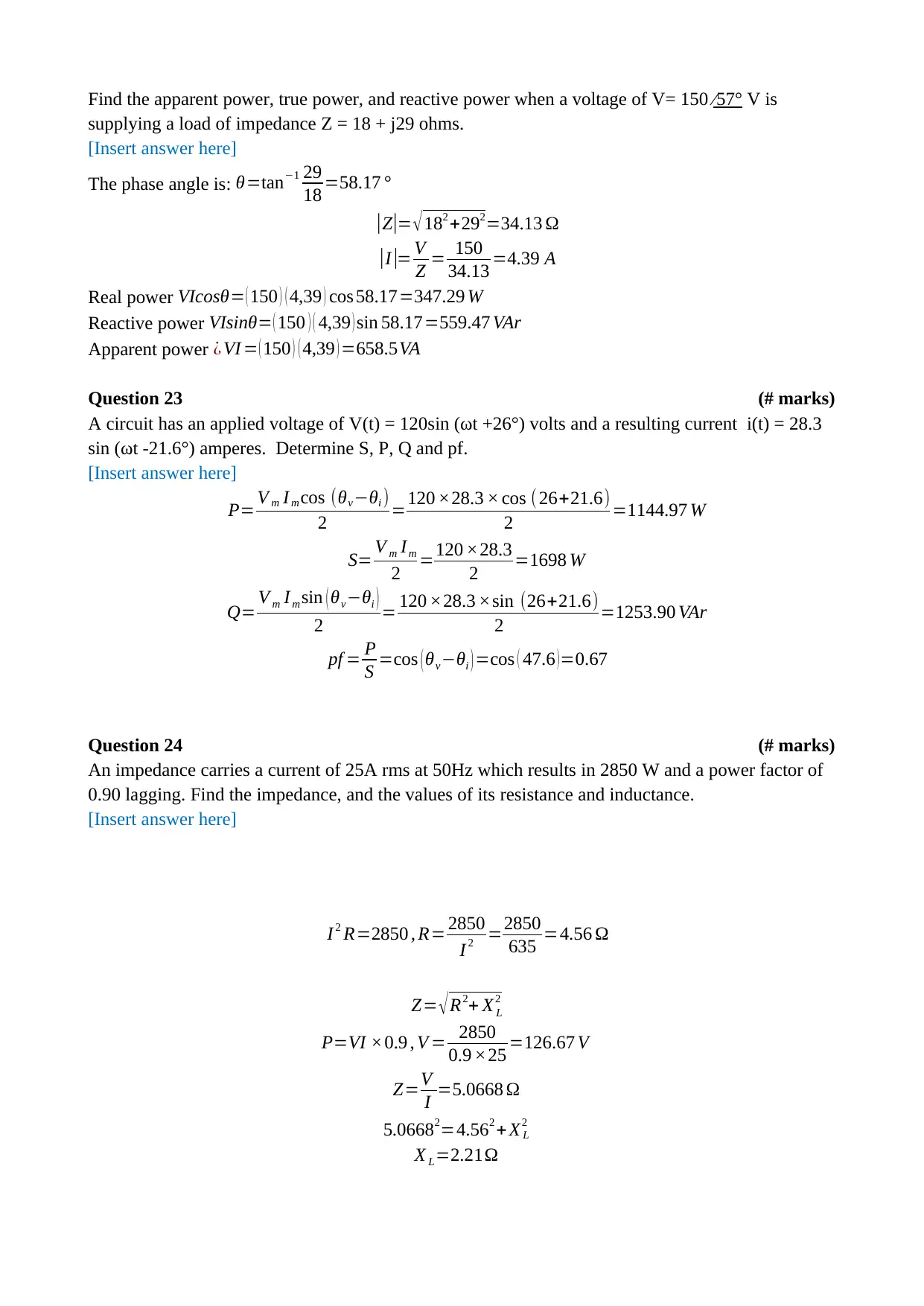
Find the apparent power, true power, and reactive power when a voltage of V= 150 ⁄57° V is
supplying a load of impedance Z = 18 + j29 ohms.
[Insert answer here]
The phase angle is: θ=tan−1 29
18 =58.17 °
|Z|= √ 182 +292=34.13 Ω
|I |= V
Z = 150
34.13 =4.39 A
Real power VIcosθ= ( 150 ) ( 4,39 ) cos 58.17=347.29 W
Reactive power VIsinθ= ( 150 ) ( 4,39 ) sin 58.17=559.47 VAr
Apparent power ¿ VI = ( 150 ) ( 4,39 ) =658.5VA
Question 23 (# marks)
A circuit has an applied voltage of V(t) = 120sin (ωt +26°) volts and a resulting current i(t) = 28.3
sin (ωt -21.6°) amperes. Determine S, P, Q and pf.
[Insert answer here]
P= V m I m cos (θv−θi )
2 =120 ×28.3 × cos (26+21.6)
2 =1144.97 W
S= V m Im
2 =120 ×28.3
2 =1698 W
Q= V m I m sin ( θv−θi )
2 = 120 ×28.3 ×sin (26+21.6)
2 =1253.90 VAr
pf = P
S =cos ( θv−θi ) =cos ( 47.6 ) =0.67
Question 24 (# marks)
An impedance carries a current of 25A rms at 50Hz which results in 2850 W and a power factor of
0.90 lagging. Find the impedance, and the values of its resistance and inductance.
[Insert answer here]
I 2 R=2850 , R= 2850
I 2 =2850
635 =4.56 Ω
Z= √ R2+ X L
2
P=VI ×0.9 , V = 2850
0.9 ×25 =126.67 V
Z=V
I =5.0668 Ω
5.06682=4.562 + X L
2
X L=2.21Ω
supplying a load of impedance Z = 18 + j29 ohms.
[Insert answer here]
The phase angle is: θ=tan−1 29
18 =58.17 °
|Z|= √ 182 +292=34.13 Ω
|I |= V
Z = 150
34.13 =4.39 A
Real power VIcosθ= ( 150 ) ( 4,39 ) cos 58.17=347.29 W
Reactive power VIsinθ= ( 150 ) ( 4,39 ) sin 58.17=559.47 VAr
Apparent power ¿ VI = ( 150 ) ( 4,39 ) =658.5VA
Question 23 (# marks)
A circuit has an applied voltage of V(t) = 120sin (ωt +26°) volts and a resulting current i(t) = 28.3
sin (ωt -21.6°) amperes. Determine S, P, Q and pf.
[Insert answer here]
P= V m I m cos (θv−θi )
2 =120 ×28.3 × cos (26+21.6)
2 =1144.97 W
S= V m Im
2 =120 ×28.3
2 =1698 W
Q= V m I m sin ( θv−θi )
2 = 120 ×28.3 ×sin (26+21.6)
2 =1253.90 VAr
pf = P
S =cos ( θv−θi ) =cos ( 47.6 ) =0.67
Question 24 (# marks)
An impedance carries a current of 25A rms at 50Hz which results in 2850 W and a power factor of
0.90 lagging. Find the impedance, and the values of its resistance and inductance.
[Insert answer here]
I 2 R=2850 , R= 2850
I 2 =2850
635 =4.56 Ω
Z= √ R2+ X L
2
P=VI ×0.9 , V = 2850
0.9 ×25 =126.67 V
Z=V
I =5.0668 Ω
5.06682=4.562 + X L
2
X L=2.21Ω
⊘ This is a preview!⊘
Do you want full access?
Subscribe today to unlock all pages.

Trusted by 1+ million students worldwide
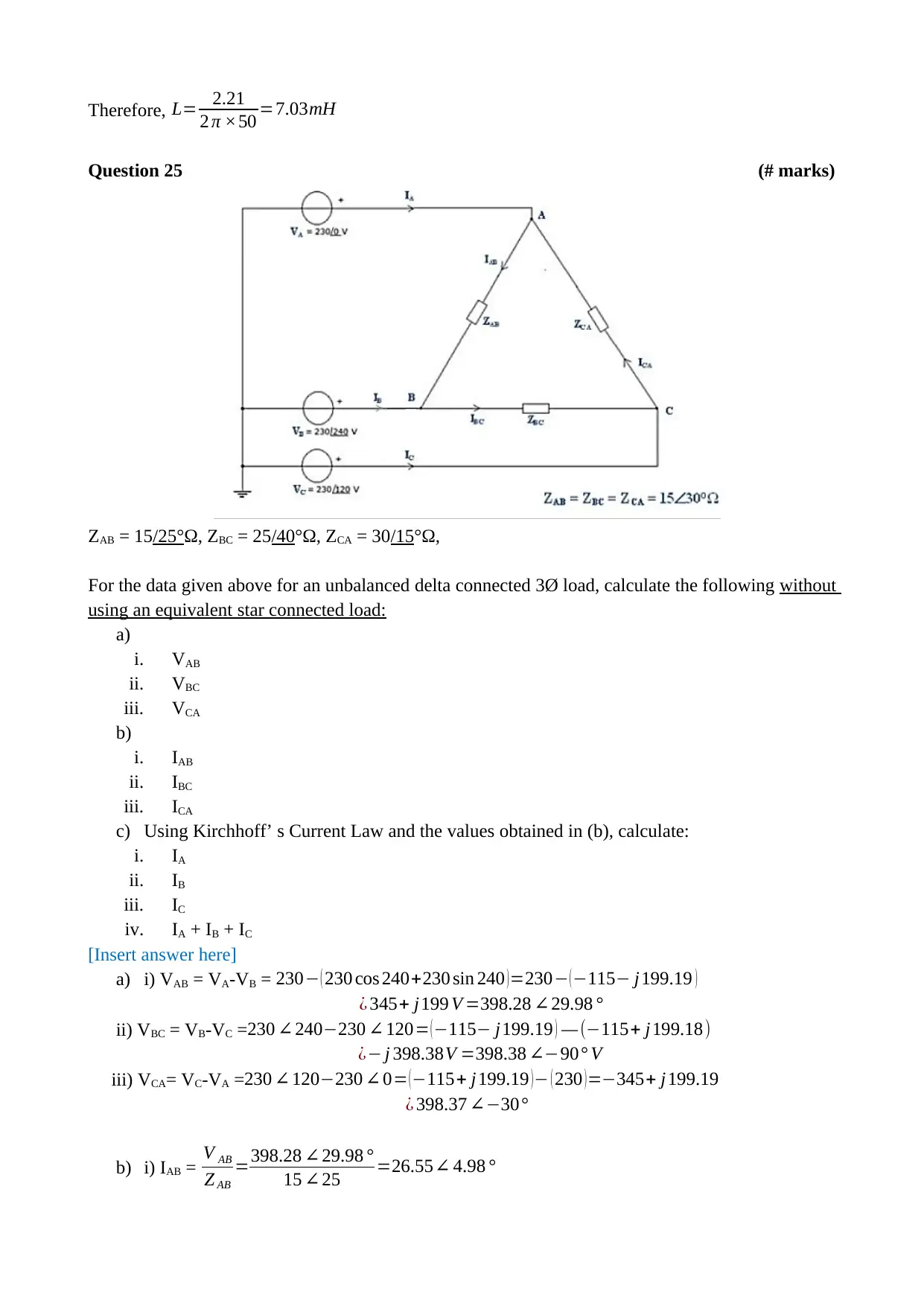
Therefore, L= 2.21
2 π ×50 =7.03mH
Question 25 (# marks)
ZAB = 15/25°Ω, ZBC = 25/40°Ω, ZCA = 30/15°Ω,
For the data given above for an unbalanced delta connected 3Ø load, calculate the following without
using an equivalent star connected load:
a)
i. VAB
ii. VBC
iii. VCA
b)
i. IAB
ii. IBC
iii. ICA
c) Using Kirchhoff’ s Current Law and the values obtained in (b), calculate:
i. IA
ii. IB
iii. IC
iv. IA + IB + IC
[Insert answer here]
a) i) VAB = VA-VB = 230− ( 230 cos 240+230 sin 240 )=230− (−115− j199.19 )
¿ 345+ j199 V =398.28 ∠29.98 °
ii) VBC = VB-VC =230 ∠ 240−230 ∠ 120= ( −115− j199.19 ) — (−115+ j199.18)
¿− j 398.38V =398.38 ∠−90° V
iii) VCA= VC-VA =230 ∠120−230 ∠ 0= (−115+ j199.19 )− ( 230 )=−345+ j199.19
¿ 398.37 ∠−30°
b) i) IAB = V AB
Z AB
=398.28 ∠ 29.98 °
15 ∠ 25 =26.55∠ 4.98 °
2 π ×50 =7.03mH
Question 25 (# marks)
ZAB = 15/25°Ω, ZBC = 25/40°Ω, ZCA = 30/15°Ω,
For the data given above for an unbalanced delta connected 3Ø load, calculate the following without
using an equivalent star connected load:
a)
i. VAB
ii. VBC
iii. VCA
b)
i. IAB
ii. IBC
iii. ICA
c) Using Kirchhoff’ s Current Law and the values obtained in (b), calculate:
i. IA
ii. IB
iii. IC
iv. IA + IB + IC
[Insert answer here]
a) i) VAB = VA-VB = 230− ( 230 cos 240+230 sin 240 )=230− (−115− j199.19 )
¿ 345+ j199 V =398.28 ∠29.98 °
ii) VBC = VB-VC =230 ∠ 240−230 ∠ 120= ( −115− j199.19 ) — (−115+ j199.18)
¿− j 398.38V =398.38 ∠−90° V
iii) VCA= VC-VA =230 ∠120−230 ∠ 0= (−115+ j199.19 )− ( 230 )=−345+ j199.19
¿ 398.37 ∠−30°
b) i) IAB = V AB
Z AB
=398.28 ∠ 29.98 °
15 ∠ 25 =26.55∠ 4.98 °
Paraphrase This Document
Need a fresh take? Get an instant paraphrase of this document with our AI Paraphraser
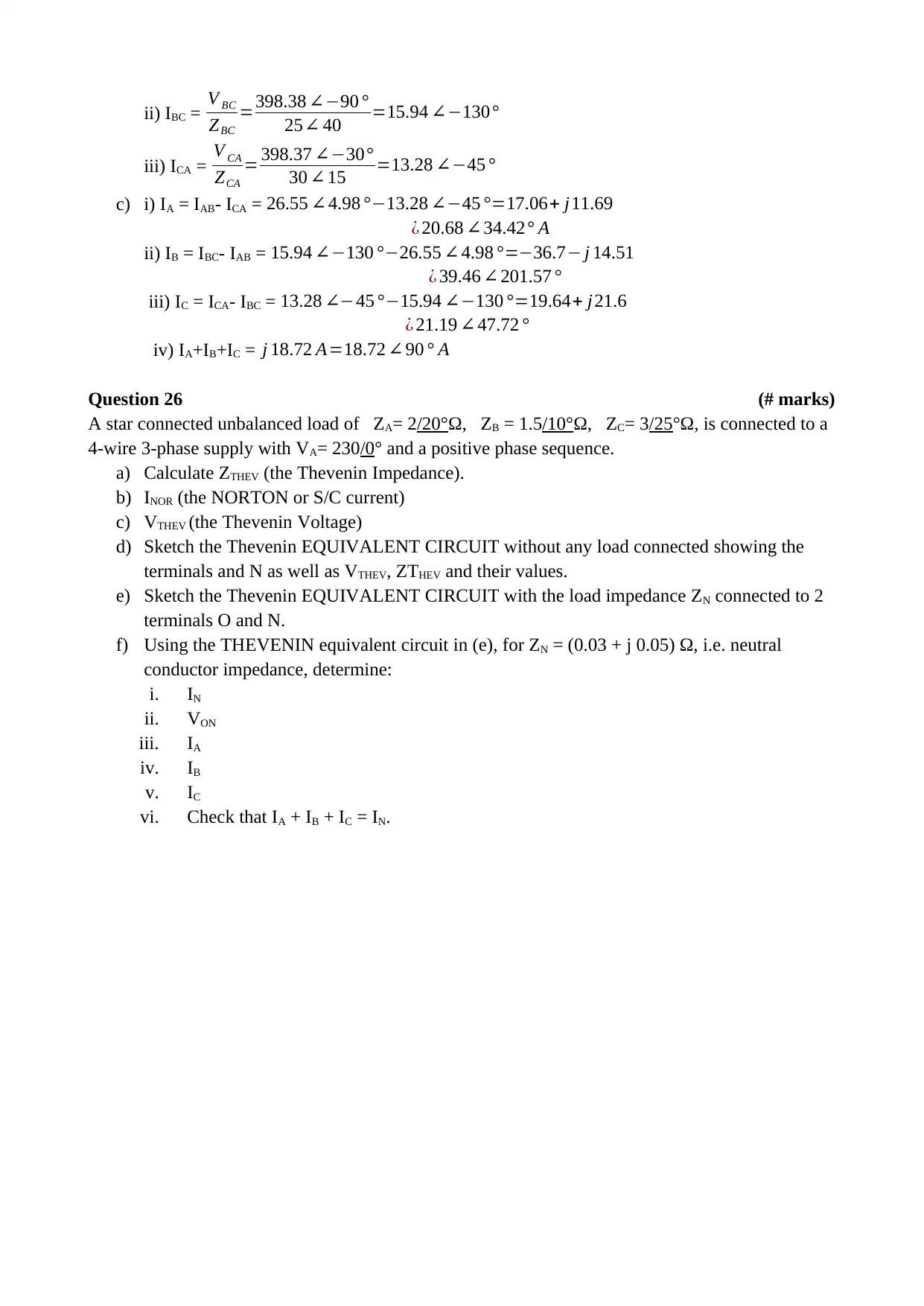
ii) IBC = V BC
ZBC
=398.38 ∠−90 °
25∠ 40 =15.94 ∠−130°
iii) ICA = V CA
ZCA
= 398.37 ∠−30°
30 ∠ 15 =13.28 ∠−45 °
c) i) IA = IAB- ICA = 26.55 ∠4.98 °−13.28 ∠−45 °=17.06+ j11.69
¿ 20.68 ∠34.42° A
ii) IB = IBC- IAB = 15.94 ∠−130 °−26.55 ∠ 4.98 °=−36.7− j 14.51
¿ 39.46 ∠201.57 °
iii) IC = ICA- IBC = 13.28 ∠−45 °−15.94 ∠−130 °=19.64+ j21.6
¿ 21.19 ∠47.72 °
iv) IA+IB+IC = j 18.72 A=18.72 ∠90 ° A
Question 26 (# marks)
A star connected unbalanced load of ZA= 2/20°Ω, ZB = 1.5/10°Ω, ZC= 3/25°Ω, is connected to a
4-wire 3-phase supply with VA= 230/0° and a positive phase sequence.
a) Calculate ZTHEV (the Thevenin Impedance).
b) INOR (the NORTON or S/C current)
c) VTHEV (the Thevenin Voltage)
d) Sketch the Thevenin EQUIVALENT CIRCUIT without any load connected showing the
terminals and N as well as VTHEV, ZTHEV and their values.
e) Sketch the Thevenin EQUIVALENT CIRCUIT with the load impedance ZN connected to 2
terminals O and N.
f) Using the THEVENIN equivalent circuit in (e), for ZN = (0.03 + j 0.05) Ω, i.e. neutral
conductor impedance, determine:
i. IN
ii. VON
iii. IA
iv. IB
v. IC
vi. Check that IA + IB + IC = IN.
ZBC
=398.38 ∠−90 °
25∠ 40 =15.94 ∠−130°
iii) ICA = V CA
ZCA
= 398.37 ∠−30°
30 ∠ 15 =13.28 ∠−45 °
c) i) IA = IAB- ICA = 26.55 ∠4.98 °−13.28 ∠−45 °=17.06+ j11.69
¿ 20.68 ∠34.42° A
ii) IB = IBC- IAB = 15.94 ∠−130 °−26.55 ∠ 4.98 °=−36.7− j 14.51
¿ 39.46 ∠201.57 °
iii) IC = ICA- IBC = 13.28 ∠−45 °−15.94 ∠−130 °=19.64+ j21.6
¿ 21.19 ∠47.72 °
iv) IA+IB+IC = j 18.72 A=18.72 ∠90 ° A
Question 26 (# marks)
A star connected unbalanced load of ZA= 2/20°Ω, ZB = 1.5/10°Ω, ZC= 3/25°Ω, is connected to a
4-wire 3-phase supply with VA= 230/0° and a positive phase sequence.
a) Calculate ZTHEV (the Thevenin Impedance).
b) INOR (the NORTON or S/C current)
c) VTHEV (the Thevenin Voltage)
d) Sketch the Thevenin EQUIVALENT CIRCUIT without any load connected showing the
terminals and N as well as VTHEV, ZTHEV and their values.
e) Sketch the Thevenin EQUIVALENT CIRCUIT with the load impedance ZN connected to 2
terminals O and N.
f) Using the THEVENIN equivalent circuit in (e), for ZN = (0.03 + j 0.05) Ω, i.e. neutral
conductor impedance, determine:
i. IN
ii. VON
iii. IA
iv. IB
v. IC
vi. Check that IA + IB + IC = IN.
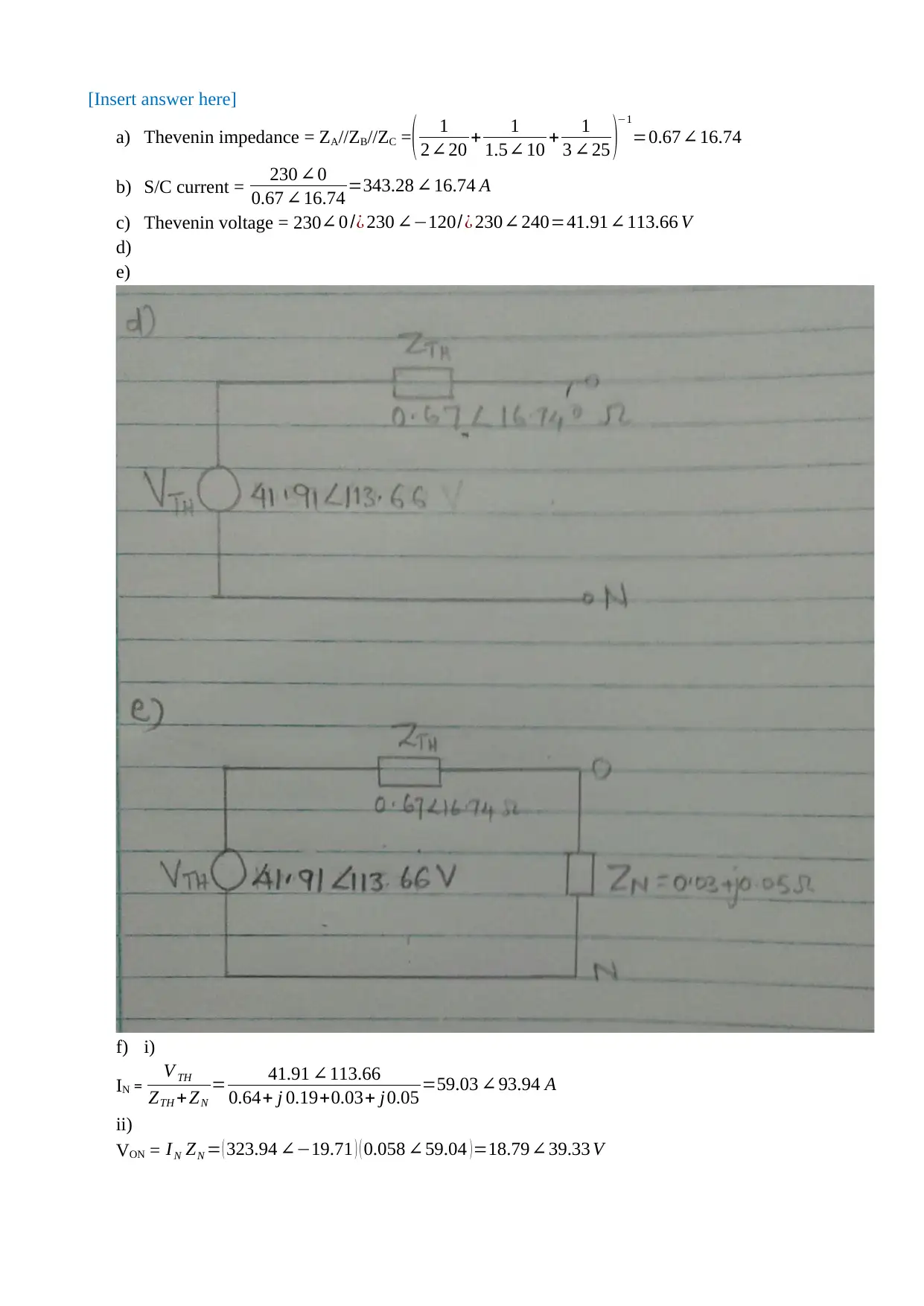
[Insert answer here]
a) Thevenin impedance = ZA//ZB//ZC =( 1
2∠20 + 1
1.5∠10 + 1
3 ∠ 25 )
−1
=0.67∠16.74
b) S/C current = 230 ∠0
0.67 ∠ 16.74 =343.28 ∠ 16.74 A
c) Thevenin voltage = 230∠ 0 /¿ 230 ∠−120/¿ 230∠ 240=41.91∠113.66 V
d)
e)
f) i)
IN = V TH
ZTH +ZN
= 41.91 ∠113.66
0.64+ j 0.19+0.03+ j0.05 =59.03 ∠ 93.94 A
ii)
VON = IN ZN = ( 323.94 ∠−19.71 ) ( 0.058 ∠59.04 ) =18.79∠39.33 V
a) Thevenin impedance = ZA//ZB//ZC =( 1
2∠20 + 1
1.5∠10 + 1
3 ∠ 25 )
−1
=0.67∠16.74
b) S/C current = 230 ∠0
0.67 ∠ 16.74 =343.28 ∠ 16.74 A
c) Thevenin voltage = 230∠ 0 /¿ 230 ∠−120/¿ 230∠ 240=41.91∠113.66 V
d)
e)
f) i)
IN = V TH
ZTH +ZN
= 41.91 ∠113.66
0.64+ j 0.19+0.03+ j0.05 =59.03 ∠ 93.94 A
ii)
VON = IN ZN = ( 323.94 ∠−19.71 ) ( 0.058 ∠59.04 ) =18.79∠39.33 V
⊘ This is a preview!⊘
Do you want full access?
Subscribe today to unlock all pages.

Trusted by 1+ million students worldwide
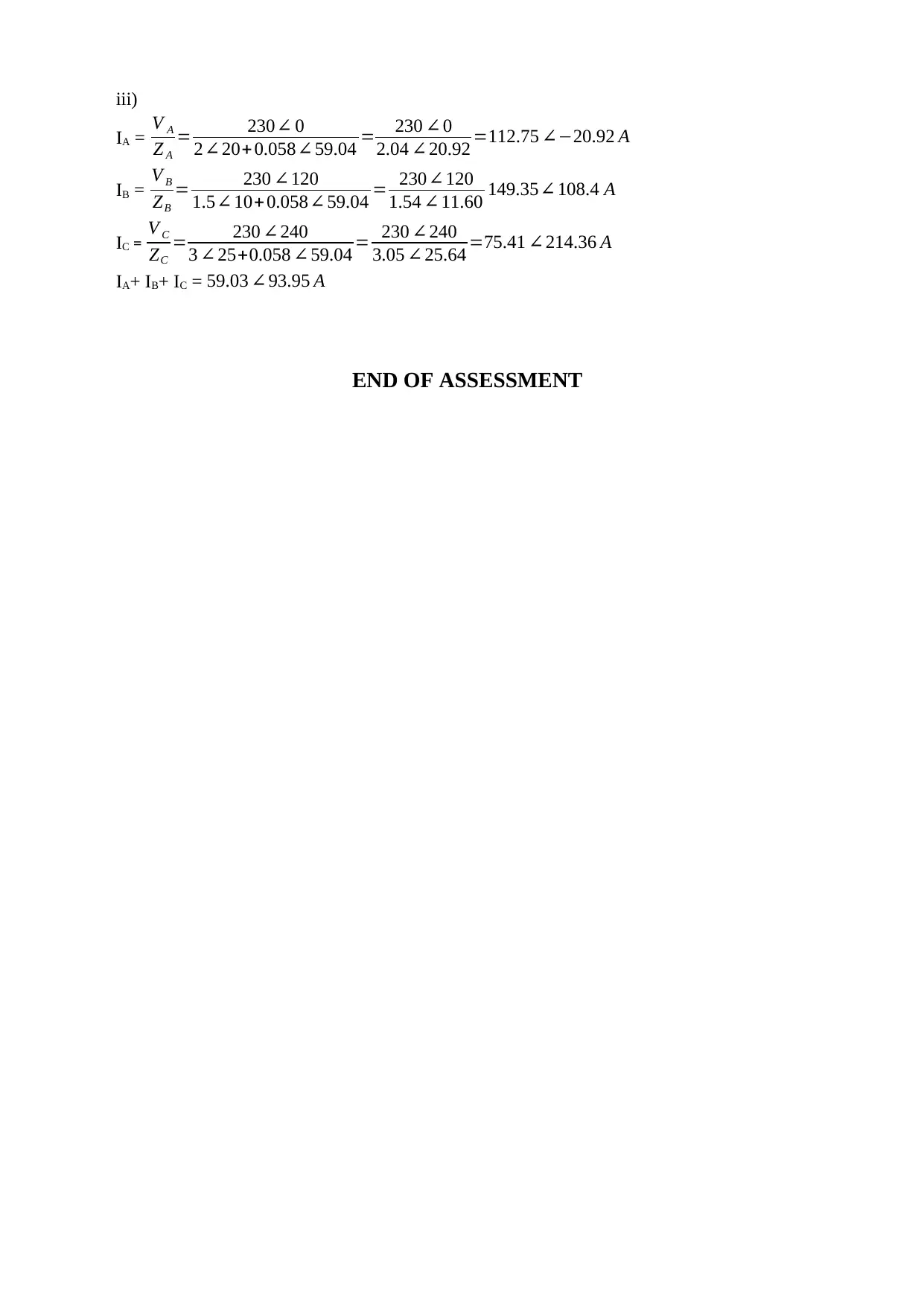
iii)
IA = V A
Z A
= 230∠ 0
2∠20+ 0.058∠ 59.04 = 230 ∠0
2.04 ∠ 20.92 =112.75 ∠−20.92 A
IB = V B
ZB
= 230 ∠120
1.5∠ 10+ 0.058∠ 59.04 = 230∠120
1.54 ∠11.60 149.35∠108.4 A
IC = V C
ZC
= 230 ∠ 240
3 ∠25+0.058 ∠ 59.04 = 230 ∠ 240
3.05 ∠ 25.64 =75.41 ∠214.36 A
IA+ IB+ IC = 59.03 ∠ 93.95 A
END OF ASSESSMENT
IA = V A
Z A
= 230∠ 0
2∠20+ 0.058∠ 59.04 = 230 ∠0
2.04 ∠ 20.92 =112.75 ∠−20.92 A
IB = V B
ZB
= 230 ∠120
1.5∠ 10+ 0.058∠ 59.04 = 230∠120
1.54 ∠11.60 149.35∠108.4 A
IC = V C
ZC
= 230 ∠ 240
3 ∠25+0.058 ∠ 59.04 = 230 ∠ 240
3.05 ∠ 25.64 =75.41 ∠214.36 A
IA+ IB+ IC = 59.03 ∠ 93.95 A
END OF ASSESSMENT
1 out of 10
Your All-in-One AI-Powered Toolkit for Academic Success.
+13062052269
info@desklib.com
Available 24*7 on WhatsApp / Email
![[object Object]](/_next/static/media/star-bottom.7253800d.svg)
Unlock your academic potential
Copyright © 2020–2025 A2Z Services. All Rights Reserved. Developed and managed by ZUCOL.